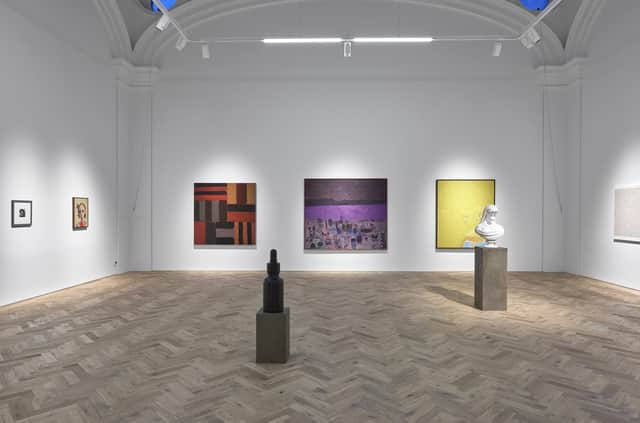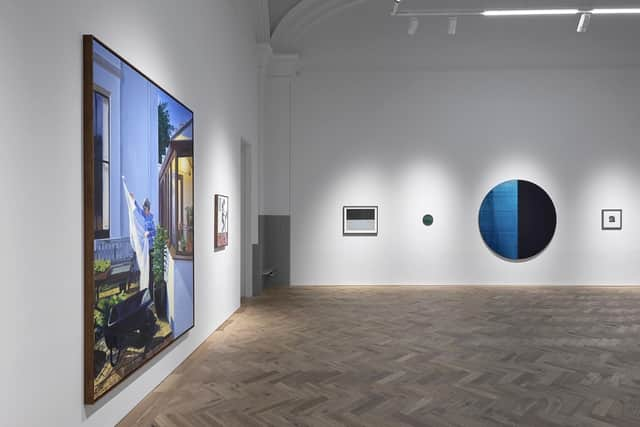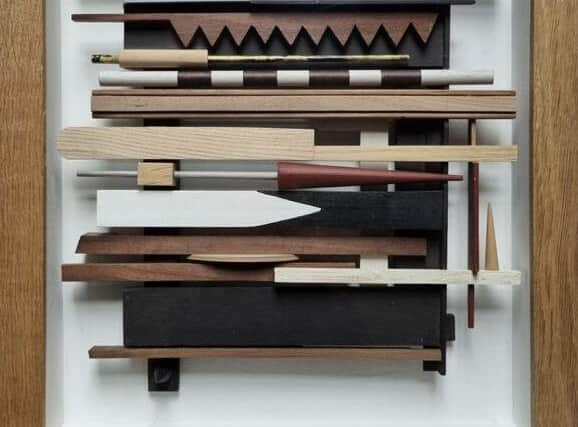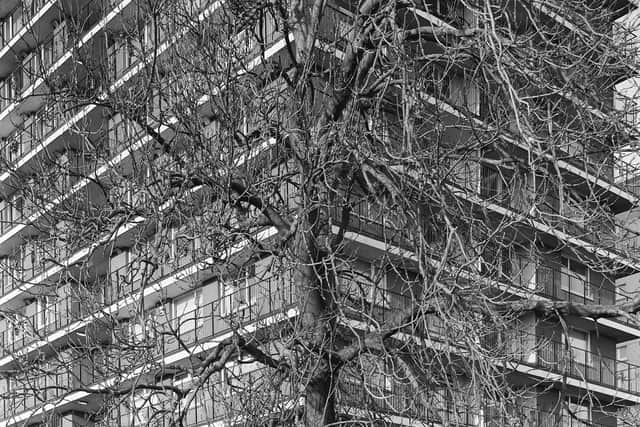Art reviews: Twenty-Five at Ingleby | Contemporary at the Scottish Gallery | Paul Drake at ECAC


Twenty-Five, Ingleby Gallery, Edinburgh ****
Contemporary, The Scottish Gallery, Edinburgh ****
Paul Duke: No Ruined Stone, City Art Centre, Edinburgh ***


The Ingleby Gallery is 25 years old and, aptly, is marking its quarter century with a show named Twenty-Five. The idea is that each of the gallery’s 25 years is represented by a single artist, but others have been added bringing the numbers up to 35. It all began in 1998 when Richard and Florence Ingleby turned the ground floor of their house in Carlton Terrace into a gallery – a house in which they were then also bringing up two small daughters. Their ambition was to show Scottish artists who didn’t quite fit into the cosier patterns of artistic life in the country, but who might nevertheless have international appeal. This soon expanded to bringing artists with international reputations to Scotland.
Richard Ingleby recalls how when they began in 1998, it was an optimistic time in Scotland. At Westminster, years of Tory rule had ended and the opening of the new parliament in Edinburgh was imminent. For the next ten years, the Carlton Terrace house served well, but, says Richard, it was small and there was just too much architecture – doors, fireplaces, windows etc. Success had bred ambition. More space was needed and the Inglebys acquired and converted beautifully a building next to Waverley Station. It made a lovely, spacious gallery, but if 1998 had been an auspicious year, 2008 was not. The new gallery opened into the financial crash. For ten years it flourished, but was eventually not viable. With the assistance of the Scottish Historic Buildings Trust, a new home was found in the former Glasite Meeting House on Barony Street. The defunct Glasite sect literally made a meal out of Christian communion. A pious feast, it meant they needed a kitchen and a dining hall in addition to a meeting room for the congregation to worship. These features are all still there, but for five years, now, this remarkable building has worked brilliantly as a gallery. Of course the wide, top-lit meeting room is the main space, but the rest of the building joins in and the present show uses almost all of it.
Advertisement
Hide AdIf the art the Inglebys have chosen to represent over the years had a single unifying characteristic, it might be a tendency towards the minimal, intellectual and conceptual. Peter Liversidge’s neon Hee-Haw with an accompanying explanation about donkeys and coarse laughs is pretty purely conceptual. So is A View of Chile / Chile’s Acidic Soil Medium, by Marine Hugonnier. Indeed, it is so conceptual it only registers as art in the accompanying written record by the artist and a restorer recording their joint intervention in a “found” painting.
But the gallery has also championed more simply visual artists. Callum Innes, a master of pure painting, has been with it since the beginning. Abstract painter Sean Scully and the American, Ellsworth Kelly, are both represented here, too. Kelly is minimal certainly, but his command of the economy of colour and form is unmatched. Amongst other painters, the gallery has also championed Andrew Cranston and Craigie Aitchison. Cranston’s eminently painterly Something of the Night even has distant echoes of Van Gogh while Aitchison’s Boy seated with Crucifixion is typically wistful and poetic.


Over 25 years the Inglebys have been pretty sure-footed in these choices, but not all their geese swans. At times the minimal leans towards the point where it scarcely exists at all without an explanatory label. Ben Cauchi’s untitled ambrotypes are beautiful but, as one critic said of Turner, they are pictures of nothing and very like. Caroline Walker’s large painting, Covering, Late Evening, June, is photographic, but without special pleading – it shows the artist’s mother going about her daily tasks – and perhaps not even then, it is pretty banal. There is also one of Jonathan Owen’s vandalised Victorian marble busts, here. Owen knocks out the faces from portrait busts and replaces them with his own “interventions”, a rather tasteless presumption of his own superiority to the evidently nameless, though certainly more skilled, originator of the piece.
One of the greatest strengths of the gallery, however, has been its championing of the work of artists who explore the interface of art and photography, often in highly original ways. Susan Derges’s magical – or magically – photographic images of the movement of water are ravishing. So too is Thomas Joshua Cooper’s work as artist-explorer, represented here by a stunning, almost all-white photograph of The Polar Plateau, Antarctica, taken at that chilly point on the temperature gauge where the numerical values of Centigrade and Fahrenheit coincide at around minus 40. Garry Fabian Miller also uses a photographic process to make exquisite images; here they are of delicate, star-shaped flowers.
Katie Paterson, championed early by the gallery, has become an international star. She appears in person here in a photograph poised dangerously above a raging waterfall in Iceland adding an intricately conceived cosmic droplet to its mighty torrent. Of all the artists represented, she is perhaps closest in the mix she achieves of vision, poetry and profound commentary on the human condition to Ian Hamilton Finlay. Identified with the gallery for many years, his work is always on view there in a changing display in the kitchen, a charming reflection of the domestic environment of his home at Stonypath where it was all conceived. Finlay personifies the Inglebys’ ambition to reach an international audience from a strong Scottish base. In that indeed they have been brilliantly successful. Twenty-five years is, I am sure, just a start.
In Contemporary at the Scottish Gallery there is also a miscellany of artists. They include David Cass with a hundred tiny seascapes mostly on tin lids and each dated to a day. David Cook’s seascapes are very different and, like his flowers, very richly painted. Doug Cocker is represented by a group of his remarkable essays in complex and exquisite carpentry. These are abstract with frequent echoes of music, but also of still-life. White Vessel and Glass really is a still-life rendered in a three-dimensional perspective worthy of Picasso. Wood is also the chosen material of Richard Goldsworthy. He cuts and carves and fastidiously blackens it with fire to create contrasts of burnt black and pale, bare surfaces. Calum McClure’s freely painted landscapes are impressive. So too is Christine McArthur’s still-life, particularly a large and simple painting of lemons.
Advertisement
Hide Ad

Kate Downie’s broad, matter-of-fact paintings of motorways and building sites overlap with a show downstairs titled Art and Industry, which includes work both by her and by David Cook along with work by other contemporaries like Lachlan Goudie. Of special interest here, however, is a group of paintings of industrial sites by David McClure, evidently having a social-realist moment in the 1950s. They are accompanied by similar works by Adam Bruce Thomson, Aleksander Zyw and a striking painting by Robert Eadie of Glasgow Docks from the 1920s.
Defying the picturesque, these landscapes find an echo in No Ruined Stone, Paul Duke’s bleak photographs of Muirhouse at Edinburgh City Art Centre. The artist has returned to the environment of his childhood to record its crumbling and unforgiving townscape, but he relieves the bleakness of his vision with striking portraits of people who live there. Like the plants he records pushing through the concrete, their humanity defies their environment.
Twenty-Five until 1 April; Contemporary until 25 February; Paul Drake until 18 February